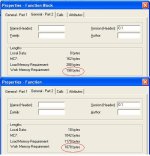I am developing for an S7-1200 in Total Integrated Automation v11 and I see these different local variable types in a function block.
It looks like they are all for conventions and dont throw errors if you use them wrong but can someone run down what each should be used for (especially static and temp).
It looks like they are all for conventions and dont throw errors if you use them wrong but can someone run down what each should be used for (especially static and temp).








